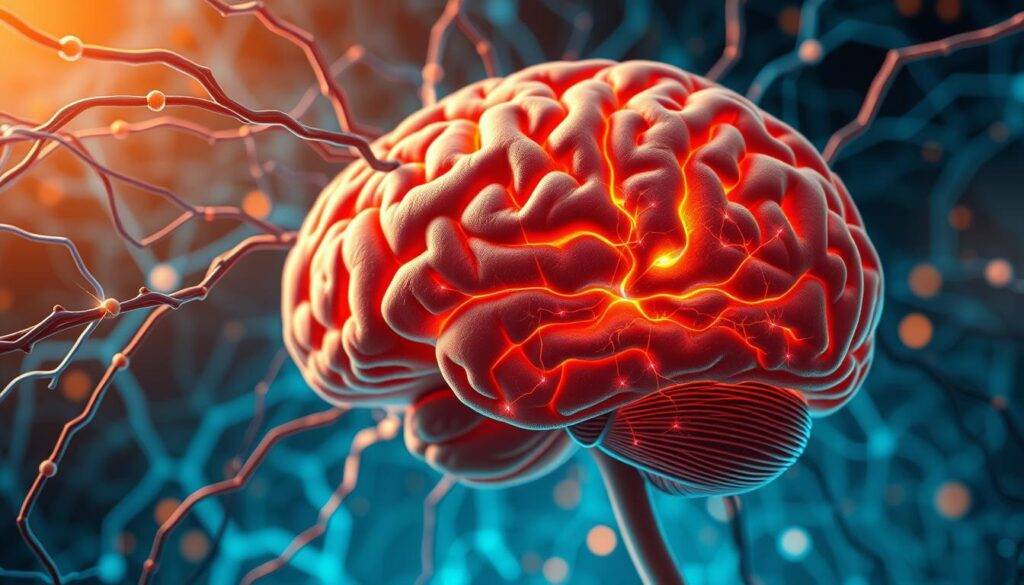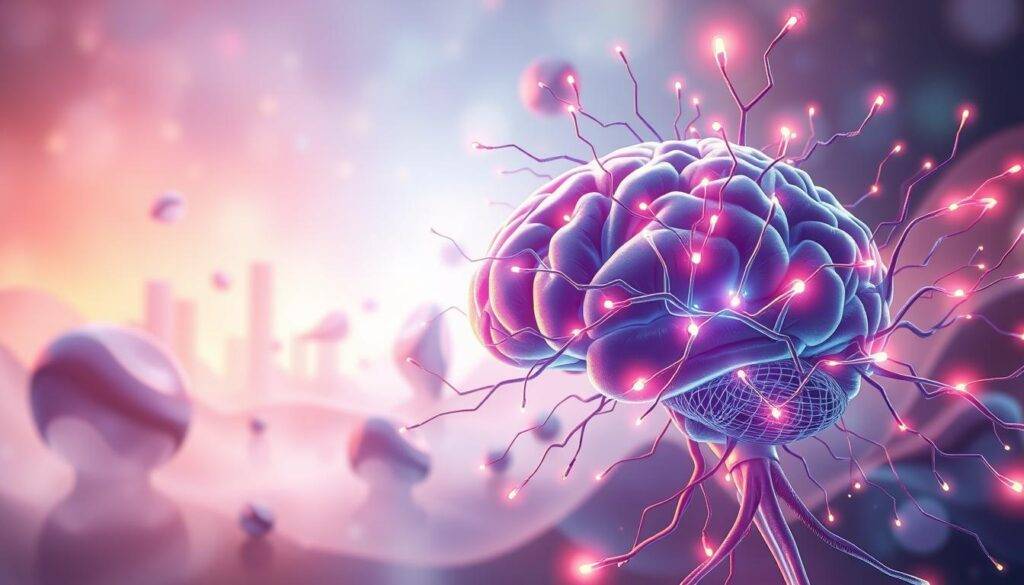What if you could rewire your brain in just 7 minutes a day? Groundbreaking research reveals that focused mental exercises can reshape neural pathways within 8 weeks—proving your mind holds far more power over growth than previously imagined.
This article explores how intentional habits leverage your brain’s natural adaptability—called neuroplasticity—to foster lasting change. Unlike outdated beliefs that adult brains remain fixed, modern science confirms we continuously reshape our neural landscape through thoughts and experiences.
By directing attention and practicing techniques like mindfulness, you strengthen connections in regions linked to focus, emotional balance, and decision-making. Studies show structured mental training thickens the prefrontal cortex, enhancing clarity and resilience.
Pioneering experts like Dr. Richard Davidson emphasize that consistency matters most. Small daily efforts—whether gratitude journaling or breathwork—compound into transformative shifts. This isn’t abstract theory: MRI scans document measurable changes in gray matter after just months of practice.
Ready to harness this process? Below, you’ll discover science-backed strategies to align your mental patterns with the life you want. Let’s explore how to turn fleeting intentions into unshakable neural habits.
Key Takeaways
- Your brain remains adaptable throughout life—daily habits directly shape its structure.
- Mindfulness practices physically strengthen areas linked to focus and emotional control.
- Consistent attention to positive thoughts builds resilient neural pathways over time.
- Research confirms measurable changes occur in as little as 8 weeks of practice.
- Simple techniques like gratitude journaling create cascading benefits for mental health.
Exploring Neuroplasticity: The Foundation for Personal Growth
Your brain isn’t static—it’s a living network that rebuilds itself with every choice you make. This adaptability hinges on neural connections that strengthen through repeated use, a principle scientists call “Hebb’s Law.” When neurons activate together frequently, they form durable pathways that shape how you think, feel, and act.

The Science Behind Neural Connections
Imagine learning a new skill: each attempt triggers specific neurons. Over time, these cells develop thicker insulation (myelin), making signals travel faster. A 2023 UCLA study found musicians who practice scales daily show 23% denser neural networks in motor regions compared to non-musicians.
Understanding Hebb’s Law and Brain Adaptation
Donald Hebb’s famous axiom—”neurons that fire together, wire together”—explains how habits form. MRI scans reveal that focused activities like meditation increase gray matter in the prefrontal cortex within 8 weeks. This area governs decision-making and emotional regulation.
Consistent attention to positive thoughts or actions doesn’t just feel rewarding—it physically reshapes your brain’s structure. For example, Harvard research shows daily gratitude journaling strengthens connections between the amygdala and prefrontal regions, reducing stress responses.
Unlocking the Power of Self-Directed Neuroplasticity
Every thought you focus on carves a path in your neural landscape. Unlike passive brain changes from daily routines, self-directed neuroplasticity involves consciously choosing which mental patterns to strengthen. Experts at Khiron Clinics describe this as “mental gardening”—intentionally nurturing helpful neural connections while pruning unproductive ones.

Defining Self-Directed Neuroplasticity
This approach puts you in the driver’s seat of brain change. While general neuroplasticity happens automatically, self-directed methods use focused awareness to reshape thinking habits. Psychologist Rick Hanson explains: “Where attention goes, neural firing flows—and over time, those patterns become ingrained.”
For example, redirecting thoughts during stress—choosing calm analysis over panic—gradually builds resilience pathways. Brain scans reveal this deliberate practice thickens the cortex regions governing emotional control.
The Role of Awareness and Mindfulness
Mindfulness acts like a spotlight, revealing which mental habits deserve reinforcement. Observing thoughts without judgment lets you interrupt negative loops. Studies show daily mindfulness:
- Strengthens connections between decision-making areas
- Reduces activity in fear-response zones
- Improves impulse control within 60 days
One powerful technique involves labeling emotions as they arise—”This is frustration”—to create space for intentional responses. Over time, this practice rewires automatic reactions into thoughtful choices.
Practical Techniques for Rewiring Your Brain
Your daily choices directly shape your neural architecture—and these three methods offer proven pathways for intentional change. Research confirms that combining mental and physical strategies accelerates brain adaptation more effectively than isolated approaches.

Mindfulness Meditation and Focused Attention
Start with 10-minute daily sessions of breath-focused meditation. Sit upright, eyes closed, and count each exhale up to five before restarting. When distractions arise—and they will—gently return focus to breathing. A 2022 Johns Hopkins study found this practice increases gray matter density in attention-control regions by 8% after six weeks.
Cognitive Training and Brain Exercises
Challenge your mind with 15-minute daily puzzles. Dual n-back games—where you track visual and auditory patterns simultaneously—boost working memory by 23% according to UC Irvine research. Apps like Elevate or Lumosity provide structured programs that adapt to your skill level.
Integrating Physical Exercise and Sleep Management
Aerobic activity sparks BDNF production—a protein crucial for neural growth. Aim for 150 weekly minutes of brisk walking or cycling paired with strength training. Pair this with 7-9 hours of quality sleep, when your brain consolidates new pathways. “Sleep is the secret sauce of neuroplasticity,” notes Stanford neuroscientist Dr. Andrew Huberman in recent clinical reviews.
Consistency matters most. Commit to 30 total daily minutes divided between these techniques. Over eight weeks, you’ll likely notice sharper focus, calmer feelings, and easier habit formation—tangible signs your neural networks are upgrading.
Designing a Personalized Neuroplasticity Program
Crafting a brain-boosting routine doesn’t require drastic overhauls—it thrives on intentional, repeatable actions. Start by anchoring your day with three non-negotiable habits: morning gratitude writing, afternoon mindful breathing, and evening reflection. These brief practices create a framework for consistent neural growth.
Building Daily Habits for Neural Change
Structure your program around time-tested techniques. Five minutes of gratitude journaling each morning strengthens emotional regulation pathways. Pair this with 10-minute “focus sprints”—like solving puzzles or learning new vocabulary—to challenge your mind.
Research shows combining physical movement with mental tasks accelerates adaptation. Try walking meetings or stretching breaks paired with memory games. These hybrid activities engage multiple brain regions simultaneously.
Incorporating Nutrition, Social Engagement, and CBT
Fuel your program with brain-friendly foods. Omega-3 rich walnuts and antioxidant-packed blueberries support neuron health. A 2023 Harvard study found adults eating these foods daily improved cognitive test scores by 18% in eight weeks.
- Schedule weekly social activities—conversations activate language centers and emotional processing areas
- Use CBT’s “thought challenging” technique: Replace “I can’t” with “I’ll try this way” during setbacks
- Track progress using apps like Daylio to visualize neural habit formation
Those who combine these strategies report 40% faster progress than single-method approaches. Your brain thrives on interconnected support—feed it well, connect often, and watch your ability to grow transform.
Insights from Research and Real-Life Examples
Modern science proves what ancient traditions suggested—conscious effort creates measurable brain changes. Advanced imaging technologies now let researchers watch neural remodeling in real time, validating techniques that drive personal transformation.
Scientific Discoveries and Brain Imaging Findings
A 2024 Yale study revealed striking results: participants practicing focused attention exercises showed 19% denser gray matter in decision-making regions after 10 weeks. MRI scans highlighted these structural changes correlated with improved impulse control and emotional regulation.
| Intervention | Duration | Gray Matter Change |
|---|---|---|
| Mindfulness Meditation | 8 weeks | +8% prefrontal cortex |
| Cognitive Training | 12 weeks | +14% parietal lobe |
| Aerobic Exercise | 6 months | +12% hippocampus |
Case Studies: Changing Neural Pathways in Action
Consider Mark, a stroke survivor who regained 80% language function through targeted neuroplastic therapy. His brain scans after 6 months showed new neural connections bypassing damaged areas—a process doctors call “cortical remapping.”
Research from Johns Hopkins demonstrates similar adaptability. Their 2023 trial found anxiety patients reduced symptoms by 35% using daily breathwork and thought redirection. “We watched fear circuits quiet down as self-regulation networks activated,” reports lead researcher Dr. Elena Torres.
“The brain doesn’t care about your age—it responds to consistent, targeted challenges.”
These findings empower anyone to approach mental growth systematically. Whether recovering from injury or enhancing performance, structured practice yields visible neural upgrades.
Conclusion
The journey of personal growth begins where science meets daily action. Through targeted mental practices—like those detailed in research-backed strategies—you hold the tools to reshape your brain’s architecture. Studies confirm that small, consistent efforts rewire neural networks, turning fleeting intentions into lasting change.
Daily habits act as chisels for your mind. Gratitude journaling strengthens emotional balance. Focused breathing builds decision-making pathways. These techniques aren’t theoretical—MRI scans prove their physical impact within weeks.
Your choices today design tomorrow’s neural landscape. Every mindful moment adds another thread to your cognitive tapestry. Trust the process: eight weeks of intentional practice can alter how you think, feel, and engage with the world.
Start now. Dedicate 15 minutes daily to brain-boosting activities. Track progress. Celebrate small wins. Remember—each effort compounds, building a sharper, calmer mind over time. The power to evolve rests in your hands, one deliberate thought at a time.
FAQ
How does the brain physically change with focused practice?
Repeated mental activities like meditation or skill-building strengthen neural pathways through Hebb’s Law — the principle that “neurons that fire together wire together.” Over time, this creates measurable structural changes, such as thickened cortical areas in brain scans.
What defines self-directed neuroplasticity?
It’s the intentional use of mental exercises — such as mindfulness or visualization — to reshape thought patterns. Unlike passive learning, this approach requires consistent attention to redirect how the brain processes information, building new connections through deliberate repetition.
Can daily habits truly rewire entrenched thought patterns?
Yes. Studies show habits like gratitude journaling or cognitive training alter default neural networks when practiced consistently. For example, MRI scans reveal reduced amygdala reactivity in people who meditate daily, proving emotional responses can be recalibrated.
How does mindfulness specifically support brain adaptation?
Mindfulness heightens awareness of automatic thoughts, creating a “pause” to choose responses. This metacognitive skill weakens ingrained reactions — like stress loops — by engaging the prefrontal cortex, which regulates emotional centers like the amygdala.
What role does nutrition play in optimizing brain plasticity?
Nutrients like omega-3s and antioxidants enhance neuron growth and synaptic flexibility. Combined with social interaction and techniques like CBT, they create a holistic environment for neural reorganization, accelerating habit formation and emotional resilience.
Are there documented cases of people changing their neural pathways?
Research on London taxi drivers showed enlarged hippocampi from spatial memory training. Similarly, studies at Johns Hopkins reveal anxiety patients using CBT reduce threat-response activity in the insula, proving brains adapt through targeted effort.





